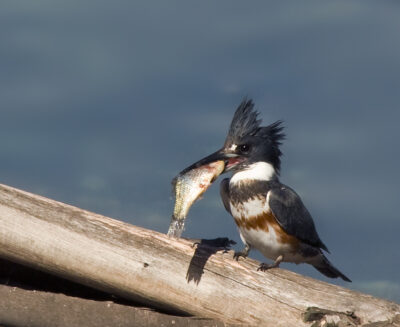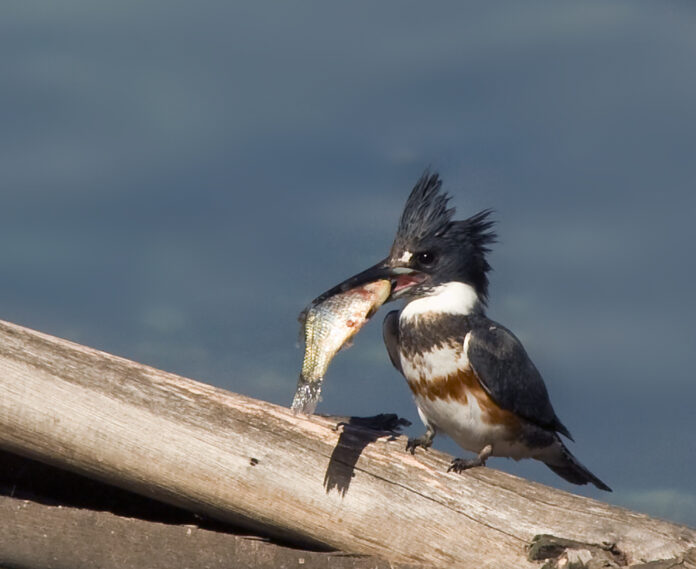BY HARRY WEEKES

I am working on empathy—that ability to “understand and share the feelings of another.” In this case, it is with the baby belted Kingfisher, now a full adolescent, whose mother seems to be yelling at him in her persistent and rattling way.
For starters, I am pretty confident on the above familial relationship. Kingfishers are one of the few birds where the female wears the colors; in this case, what looks like a russet-brown vest beneath her cool, blue overcoat. She is perched on an irrigation gate, on the edge of the pond, yelling at the trees, where a decidedly adolescent-looking bird, sans colors, is looking distracted, beleaguered, and generally confused (I probably could have left these last qualifiers out by just writing ‘adolescent male’).
And why wouldn’t he be?
Kingfisher nests are tunnels dug into banks surrounding water sources. These can be as much as 10 feet deep. So, this bird was born in total darkness, a muffled and black world, devoid of most sound and light. Periodically, mom or dad would shimmy into this world and feed his siblings and him “fishy things”—actual fish, or things like snails, crustaceans, frogs, and insects caught in or near the water.
Then, it came time to get out in the world, and our completely subterranean friend scooted to the edge of the tunnel into a world of dazzling color and light and somehow spread its wings and FLEW. This happened, no doubt, under a similar circumstance to what was unfolding when I saw the pair on the edge of the pond—the parents rattling and chortling until the only thing left to do was fly.
After that miraculous moment, which I always hope turns into several wonderful hours of aerial tricks and maneuvers but which mostly ends with a headlong plunge into the willows (after all, it doesn’t take much time to realize that right after learning to take off comes learning to land, and that is a whole other physics lesson).
Now, our bedraggled teenager is hanging out getting another lesson—eating. At what point does the Kingfisher understand that what mom wants is for him to plunge headlong into the water after the wiggly things? Does he look down and think, “Wow, I can see those fish perfectly.” Or, does he watch mom dive in, and bring a fish up, then connect at first bite this earliest of comfort foods with all of the shimmering movements just beneath the surface?
And is it that seemingly insatiable hunger of the adolescent that drives the first plunge into the water?
Putting this all together, we get a cave-dwelling, fish-eating bird who learns to navigate flying and feeding under the incessant rattling of parents that will, one day very soon, both end and also disappear. Because, the next steps are to do all of this alone, as Kingfishers tend to be solitary. For a time.
Until one day that rattle and chestnut undercoat is not mom, but the female bird with whom he will try and pass on all of these skills. He will start with a courtship that I cannot yet figure out how he learns, followed shortly thereafter by an impulse to dig a really long tunnel in the dirt.
Needless to say, while I can articulate some of the parts and pieces of a Kingfisher’s life, actual empathy seems a long way off, trailing an urgent rattling cloaked in blue and white.
Harry Weekes is the founder and head of school at The Sage School in Hailey. This is his 48th year in the Wood River Valley, where he lives with Hilary and two of their three baby adults—Penelope and Simon. The other member of the flock, Georgia, is currently fledging at Davidson College in North Carolina.



